Paul Gilster's Blog, page 239
October 15, 2012
Exoplanet Missions Beyond Kepler
Because it’s going to be an interesting week for exoplanet studies (for reasons I’ll talk about soon, though not today), I’ll lead off with some thoughts on eta-Earth, defined as the fraction of Sun-like stars with a planet like Earth orbiting them. We have a lot to learn about the frequency of terrestrial worlds, and as Philip Horzempa points out in a recent article for The Space Review, the image that’s gradually emerging is of fewer ‘Earths’ than Carl Sagan once estimated when he said in the 1980s that half of all stars could have a planet like our own.
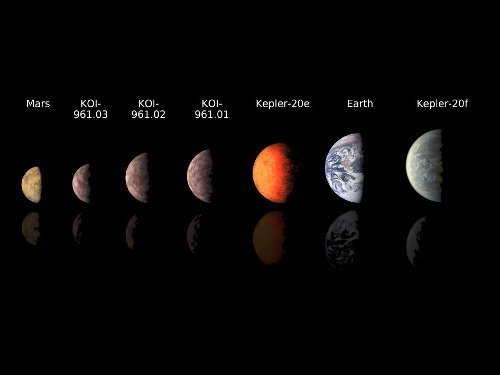
Image: Artists’ concepts of small exoplanets compared to our own planets Mars and Earth. As Kepler continues to hunt, how can we move beyond its findings to learn more about terrestrial planets around much closer stars? Credit: NASA/JPL-Caltech
With Kepler’s continuing datastream and improving ground-based instrumentation, we’re learning more about planet distribution, but Horzempa notes that even now, estimates of Earth analogs have ranged from about 2 percent to as high as 35 percent. He cites John Rehling, who went to work on biases inherent in the Kepler data set, namely that 1) the Kepler data are more complete in regions close to the host star and 2) the transit method detects larger planets more readily than small ones (see Looking Into Kepler’s Latest for more on this analysis, which appeared last March). Rehling’s findings led him to support a low 2% figure for eta-Earth but more complete Kepler data now has him backing off the number. Here’s what Horzempa says on the matter:
[Rehling’s] analysis has shown that the abundance curves for certain planet types, such as super-Earths, do not follow a smooth distribution curve. Rather, there is a peak, followed by a falloff, with increasing distance from the parent star. The distribution curve for Earth-sized worlds shows a positive slope, so far. Therefore, at present the best that can be said about eta-Earth is that it probably has a value of 2–12%. Only an extended Kepler mission will be able to determine the actual fraction of stars that have an Earth orbiting it. A low value for eta-Earth will mean that the search for Earth analogs in nearby solar systems will need to be pursued with vigor, and with multiple approaches.
Kepler, of course, is working with a large field of stars about 2000 light years away, the idea being to gather statistical information that will help us understand the broad trends of planet distribution. The mission has been extraordinarily successful, but it’s interesting to speculate, as Horzempa does, on what missions could now follow up on its findings. The article looks at the Gaia space telescope that should be operational by 2014 as well as the New Worlds sunshade concept that could be deployed for use with the James Webb Space Telescope, but I want to focus on Horzempa’s third mission concept, an ‘Earth’ finder called NEAT.
The Nearby Earth Astrometric Telescope has been proposed to the European Space Agency as a mission that could home in on nearby terrestrial planets in ways Kepler cannot. The idea here is to fly a pair of spacecraft separated by some 40 meters, providing the needed focal length to create high angular resolution. One of the spacecraft carries a 1-meter mirror while the other is a detector probe that collects the focused light onto an array of CCDs. The goal is to detect Earth analogs within 50 light years, with an accuracy of 0.05 microarcseconds for selected targets. Says Horzempa:
The NEAT duo will observe a list of 200 nearby Sun-like stars over several years. It will be able ascertain whether planets down to a mass of 1 Earth, or larger, orbit those stars. In addition, NEAT will be able to survey the solar systems discovered by Kepler, detecting giant planets that were missed by Kepler. These would be planets that did not transit their parent star during the Kepler mission, either because of the “wrong” orbital inclination or because their orbital period is too long. This will help to “fill in” the architecture of those solar systems, allowing a better understanding of how those systems are formed.
As you can see, NEAT would require formation flying in space, something that will demand a precursor experiment that the French space agency CNES has already funded, drawing on progress in formation flying that has been achieved by Sweden’s PRISMA program. The hope of the NEAT planners is to move beyond this experiment to a smallsat follow-up called micro-NEAT, which would put the formation flying algorithms through their paces, though at a separation of 12 rather than 40 meters. Quite a lot of serious work could emerge from such a mission: Horzempa notes that micro-NEAT would be able to detect planets down to one Earth mass for our nearest neighbors, Alpha Centauri A and B. It would also be able to detect larger planets (with a lower mass limit of 10 Earth masses) around the 25 nearest stars.
You’ll want to read all of Horzempa’s essay, which will include a second installment to be published today. With funding for projects like DARWIN and Terrestrial Planet Finder in perpetual limbo, smaller missions that can advance the exoplanet hunt — and help us refine the value of eta-Earth — are the next priority. They will be designed and, let’s hope, fly in an environment enlivened with still more detailed findings from our existing space observatories as well as instruments on the ground that reveal planets in the habitable zone of their stars.
NEAT was submitted as an answer to the call for proposals for M-class space missions in ESA’s “Cosmic Vision 2015-2025″ plan. For more, see Mablet et al., “High precision astrometry mission for the detection and characterization of nearby habitable planetary systems with the Nearby Earth Astrometric Telescope (NEAT),” available online. The NEAT proposal summary is also available. A NEAT workshop was held in November of 2011 in Grenoble, France.






October 12, 2012
The Institute for Interstellar Studies
by Kelvin F. Long
I recently asked Kelvin Long to write an introduction to the Institute for Interstellar Studies he has created, and he was kind enough to send along a useful overview, along with a backgrounder on his own work: “Kelvin Long is an aerospace engineer and physicist. He is chief editor of the Journal of the British Interplanetary Society, author of the book Deep Space Propulsion: A Roadmap to Interstellar Flight, and was the key founder behind the starship design study Project Icarus. Since 2007 he has worked to catalyse the interstellar community through the organization of lectures, symposia, publications and design studies. He is currently the Executive Director for the Institute for Interstellar Studies, founded in August 2012.” Here Kelvin describes the new Institute and relates its mission to prior work in deep space technologies.
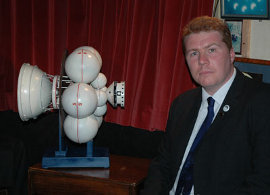
The subject of Interstellar Studies derives its name from a set of special red cover issues of the Journal of the British Interplanetary Society, published between 1974–1991. These issues included papers on interstellar communications and the Search for Extraterrestrial Intelligence (SETI). This collection of papers represents a golden age of interstellar research. Indeed, the British Interplanetary Society (established 1933) has been the ‘torch holder’ of the interstellar vision for much of the last half century. Prior to this, the first technical paper addressing the interstellar challenge was published in the same journal in 1952 by Dr Les Shepherd. This can be considered the beginning of interstellar studies as an academic research subject. Throughout the last 60 years many papers have been published addressing the science and technology associated with interstellar flight. Publications have also examined wider questions of social consequences, philosophical viewpoints and political or economic issues. This large body of work demonstrates that the interstellar challenge is one that engulfs a broad range of subjects and likely requires the application of a multitude of solution types.
In recent decades, the subject has gradually gained prominence with several books being published and documentaries made. This has occurred in conjunction with the successful rise of science fiction and the visions of other worlds or starships that these stories would have us visualise. Yet, despite this progress the subject remains unorganized, uncoordinated, un-financed. Most of the credible research is conducted by volunteers, who would perform some other occupation during the day, and design starships during the night. Several organizations have been created in recent years that seek to work towards a coordinated effort. These organizations have noble goals and mission statements but neither has succeeded in creating an umbrella organization for interstellar research or in garnering significant financial investment into the interstellar subject. Although these are excellent attempts to catalyse interstellar research, these organizations have at times struggled to work together co-operatively because of differing ideas of how to achieve the objective for mutual benefit; a necessary condition if the goal of getting the interstellar subject accepted as a mainstream research field is to be achieved.
My own observations of having worked within the interstellar community now since 2007 are what partly motivates me towards the founding of the world’s first dedicated Institute for Interstellar Studies. You could ask why is such an institute needed now? Well, we are at what may be called an inflexion point in national space programs with the emergence of space tourism and space commercialisation, the discovery of many exo-solar planets reigniting interest, all within the backdrop of apparent retreating national space programs. When DARPA and NASA Ames Research Center ran the 100 Year Starship competition, no matter who won, there was a clear message that came from this: The US government put a stamp of approval on the interstellar agenda. This is perhaps the biggest contribution they could have made. Now is the time to use this opportunity and to provide a nexus about which the interstellar community can gather around.
All of the research that has been performed to date on interstellar has been dominated by theoretical studies. These are extremely valuable and they need to continue. This includes more starship designs. I claim that there is only one “starship design” in history and that is the British Interplanetary Society Project Daedalus. This is a controversial claim, but let me explain. In aerospace design, the word ‘design’ has a specific meaning. To me it refers to going from a requirements document, producing a concept, preliminary design and then a detailed design. This includes a configuration layout, performance specification, and appropriate consideration for the systems and subsystems integration. Although the Daedalus design is not without its flaws (due to technological advancement) and design contradictions (a consequence of trying to integrate 1970s technology with several decades hence), the design does meet my criteria for what is meant by an aerospace design.
As an aside, I also refer to starship design as “extreme aerospace engineering”, because the techniques and methods by which you down select to a design solution are no different from any other conventional aerospace vehicles — it is merely the environmental requirements which are extreme. Harsh conditions of radiation exposure, thermal gradients, pressures, detonation rates, cruise velocities, risks and reliability. The only other design which comes close to Daedalus, in my opinion, is the Project Orion design which was completed to the same level of fidelity, although that was mainly for an interplanetary vehicle. To my knowledge, the “interstellar” version was never fully designed. All other papers that have been written on interstellar vehicles, are either mission or vehicle concept studies and not full designs. Hence my claim that Daedalus is the only starship design in history.
Given we only have one attempt, how can people claim that interstellar flight is not possible? We need more reliable and credible studies and this is one of the functions that the Institute for Interstellar Studies will provide. This is also one of the reasons why I created Project Icarus, which is currently managed by the non-profit Icarus Interstellar, for which I was also a co-founder and former Director. Those teams continue to do good work in addressing a wide suite of technical problems. In addition, we want to go beyond just the theoretical studies, and also pursue numerical and experimental programs. These activities will help to build the profile of interstellar, recruit numbers to our ranks, and make the case for interstellar precursor mission studies. Provided all of this is done within an organization that has a viable governance structure and a fully operational and tested program, it is my belief that the securement of investment into the interstellar community will become more viable. No philanthropist is going to invest in one small team with an idea, but they will take a second look if the business case is sound, the organization is professionally established and the cause worthy.
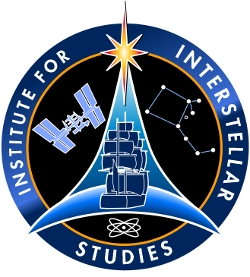
The Institute for Interstellar Studies was created in 2012, sixty years after the publication of the JBIS paper by Dr Les Shepherd. Our goal is to create a long term research strategy which pulls all of the other organizations together in a cooperative way and if we can, to invite significant investment across the field, be it with people, energy or financial assets. If we are successful, then we would share these resources with the other organizations to assist them in growing their grassroots support base, research programs and organizational structure. The vision of the Institute for Interstellar Studies is not to see one organization subsumed into another, but to create a nexus about which all of the other organizations can depend upon, so as to assist them to affect their individual mission statements to the best of their ability and resources. Each organization would then leverage the capacity and contacts of the others for mutual benefit. In addition, the institute will also undertake its own research programs as well as set up an educational academy to assist students who desire to work towards a career in space.
Similar science institutes have been created throughout history which serve as an example of what is required. One example includes the Perimeter Institute for Theoretical Physics in Canada, which opened in 2001. This is an independent research center in foundational, theoretical physics located in Waterloo, Ontario. Founded in 1999, it works to advance the understanding of physical laws and develop new ideas about space, time, matter and information. They started with an initial seed of $100 million in October 2000, received a further $50 million in June 2008. They have had annual budgets of order $50 million in both 2006 and 2007 from the Canadian government. Another example is the SETI Institute, which was founded in 1984 on a $25 million donation from Paul Allen and matched by a further $25 million donation and government grant. The institute is a not-for-profit organization whose mission is to explore, understand and explain the origin, nature and prevalence of life in the universe. Both the PI Institute and the SETI Institute do excellent work, and these organizations serve as examples for what can be accomplished, with some work. Although the Institute for Interstellar Studies begins life as a virtual entity, its ambitions are to become as big as these organizations and discussions are already under way towards the securement of a physical facility.
The current mission of the Institute for Interstellar Studies is to conduct activities or research relating to the challenges of achieving robotic and human interstellar flight. We will address the scientific, technological, political and social and cultural issues. We will seed high-risk high-gain initiatives, and foster the breakthroughs where they are required. We will work with anyone cooperatively from the global community who desires to invest their time, energy and resources towards catalyzing an interstellar civilization. Our goal is to create the conditions on Earth and in space so that starflight becomes possible by the end of the twenty-first century or sooner by helping to create an interplanetary and then an interstellar explorer species. We will seek out evidence of life beyond the Earth, wherever it is to be found. We will achieve this by harnessing knowledge, new technologies, imagination and intellectual value to create innovative design and development concepts, defined and targeted public outreach events as well as cutting edge entrepreneurial and educational programs.
The Institute for Interstellar Studies will focus its efforts on several areas, this includes:
(1) Providing a facility for fundamental research into interstellar flight.
(2) Providing an Educational Academy to support students on their careers to become space scientists or other related fields.
(3) To initiate knowledge capture activities so that information is readily available to the research community through data libraries and publications using new technology tools.
(4) To undertake educational activities which are focussed on increasing the designer capability of physicists and engineers as well as other scientific disciplines, so that we may better assess the various technical problems associated with Starship design.
(5) To create actual blueprints for Starship concepts, designs and mission demonstrators.
(6) To properly assess the requirements for an appropriate strategic and technological roadmap that will see interstellar flight become a reality over the next century.
(7) To help to foster new theoretical, computational and experimental tools to help scientists and engineers to solve the fundamental R&D problems that can make the designs become viable.
(8) To organize or contribute to symposiums, workshops or conferences, to provide an opportunity for networking and the sharing of ideas.
(9) To help communicate the vision of interstellar flight to the public, media, industry and government through the technical programs or the arts.
(10) To provide for a co-operative relationship between the institute and similar organizations, aligning programs where appropriate and seeking to work towards shared ambitions.
(11) To garner investment into the community, including financial. This can then be used for the provision of salaries and grant awards which is needed if we are to create a new industry.
Our view is that an interstellar-capable society can be established by the end of this century. What does this mean? It does not mean that by the year 2100 Starships will be travelling regularly between stars. What it means is that as a society, we will have the science knowledge, public understanding and support, political and economic provision, to begin a program for the first human mission, using the capabilities that exist at that time. That said, we believe it is quite plausible to send uncrewed robotic ambassadors towards the stars in the coming decades and the Institute will work towards that goal as a key mission and technology demonstration. We will focus on interstellar precursor missions first, but then later move towards full interstellar missions as our capability increases.
The motto of the Institute for Interstellar Studies is “Scientia ad sidera” or “Knowledge to the Stars”, because we believe in the determination of a scientifically informed strategic and technological roadmap in our planning. If people believe that what we are doing has merit, then we invite you to join with the Institute in some capacity. We are a young organization, and the world’s first ever dedicated interstellar research institute, founded in August 2012. But we are optimistically hopefully that by working together, we can bring to fruition the fulfilment of a dream and send humans to the system of another star. I challenge everyone in the interstellar community, and anyone with an interest in moving the interstellar agenda forward, to join in shared friendship and cooperation, so that we may work together towards the same aim – catalysing an interstellar society.
The web site for the Institute for Interstellar Studies can be found here: http://www.i4is.org/
The Institute’s blog page is located on our knowledge capture web site, The Interstellar Index, and can be found here: http://www.interstellarindex.com/blog/
Interested members who wish to contact the Institute can email us on:
interstellarinstitute@gmail.com






October 11, 2012
Dyson Sphere Hunt Using Kepler Data
The idea of the multiverse — an infinite number of universes co-existing with our own — has a philosophical and mathematical appeal, at least if you’re a follower of string theory. Indeed, there are those who would argue there could be as many as 10500 universes, each with its own particular characteristics, most probably inimical to the development of life. But I have to say that I’m far more interested in the universe that is demonstrably here, our own, and thus the news that Geoff Marcy has received a grant to look for Dyson spheres catches my eye more than news of a similar grant to physicist Raphael Bousso to probe multiverse theory.
Not that I have anything against Dr. Bousso (UC-Berkeley) and his work, and if he eventually does find a way to make predictions of multiverse theory that can be tested, I’m all for it. But I think the new grants, given to the researchers in a series called New Frontiers in Astronomy & Cosmology International Grants (funded through the UK’s Templeton Foundation), were wisely balanced between the practical (observational astronomy) and the highly theoretical. Marcy will use his to probe the continually swelling Kepler datastream looking for distinctive signatures.
Instead of planets, though, Marcy has more unusual targets, the vast structures Freeman Dyson hypothesized over fifty years ago that could ring or completely enclose their parent star. Such structures, the work of a Kardashev Type II civilization — one capable of drawing on the entire energy output of its star — would power the most power-hungry society and offer up reserves of energy that would support its continuing expansion into the cosmos, if it so chose. Marcy’s plan is to look at a thousand Kepler systems for telltale evidence of such structures by examining changes in light levels around the parent star.

Image: A Dyson sphere under construction. Credit: Steve Bowers.
Interestingly, the grant of $200,000 goes beyond the Dyson sphere search to look into possible laser traffic among extraterrestrial civilizations. Says Marcy:
“Technological civilizations may communicate with their space probes located throughout the galaxy by using laser beams, either in visible light or infrared light. Laser light is detectable from other civilizations because the power is concentrated into a narrow beam and the light is all at one specific color or frequency. The lasers outshine the host star at the color of the laser.”
The topic of Dyson spheres calls Richard Carrigan to mind. The retired Fermilab physicist has studied data from the Infrared Astronomical Satellite (IRAS) to identify objects that radiate waste heat in ways that imply a star completely enclosed by a Dyson sphere. This is unconventional SETI in that it presumes no beacons deliberately announcing themselves to the cosmos, but instead looks for signs of civilization that are the natural consequences of physics.
Carrigan has estimated that a star like the Sun, if enclosed with a shell at the radius of the Earth, would re-radiate its energies at approximately 300 Kelvin. Marcy will turn some of the thinking behind what Carrigan calls ‘cosmic archaeology’ toward stellar systems we now know to have planets, thanks to the work of Kepler. Ultimately, Carrigan’s ‘archaeology’ could extend to planetary atmospheres possibly marked by industrial activity, or perhaps forms of large-scale engineering other than Dyson spheres that may be acquired through astronomical surveys and remain waiting in our data to be discovered. All this reminds us once again how the model for SETI is changing.
For more, see two Richard Carrigan papers, the first being “IRAS-based Whole-Sky Upper Limit on Dyson Spheres,” Journal of Astrophysics 698 (2009), pp. 2075-2086 (preprint), and “Starry Messages: Searching for Signatures of Interstellar Archaeology,” JBIS 63 (2010), p. 90 (preprint). Also see James Annis, “Placing a limit on star-fed Kardashev type III civilisations,” JBIS 52, pp.33-36 (1999). A recent Centauri Dreams story on all this is Interstellar Archaeology on the Galactic Scale but see also Searching for Dyson Spheres and Toward an Interstellar Archaeology.






October 10, 2012
Musings on Solitude and Contact
Back in 2007, science writer Lee Billings put together a panel for Seed Media Group on “The Future of the Vision for Space Exploration.” The session took place at the Rayburn House Office Building on Capitol Hill, and I remember flying to Washington with a bad head cold to moderate the event. Miraculously, my cold abated and I enjoyed the company of Louis Friedman (The Planetary Society), Steven Squyres (of Mars rover fame), Edward Belbruno (Princeton University) and interstellar guru Greg Matloff (CUNY). But I particularly remember conversations with Lee. I can’t say I was surprised to see him go on to emerge as one of the most gifted science writers now working.
Not long afterwards, Lee wrote an essay called The Long Shot for SEED Magazine that took him into the thick of the exoplanet hunt, from which this fine paragraph about the nearest stars and why they have such a hold on us:
Alpha Centauri is today what the Moon and Mars were to prior generations—something almost insurmountably far away, but still close enough to beckon the aspirational few who seek to dramatically extend the frontiers of human knowledge and achievement. For centuries, it has been a canonical target of the scientific quest to learn whether life and intelligence exist elsewhere. The history of that search is littered with cautionary tales of dreamers whose optimism blinded them to the humbling, frightful notion of a universe inscrutable, abandoned, and silent.
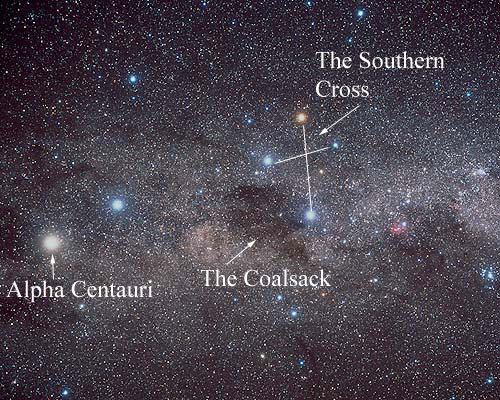
Image: Alpha Centauri and nearby stars. Notice that Centauri A, B and Proxima Centauri all appear as a single light source. Credit: Akira Fujii/David Malin.
I have to add my own cautionary note, that Billings and I share the view that intelligent life is rare in the galaxy, though I suspect that Lee would be as pleased to be proven wrong as I would. I mention all this because these topics will come up in detail in a book he is now working on called (with a nod to Gabriel García Márquez) Five Billion Years of Solitude, which starts with the search for planets like Earth but moves to a broader view that places our world in a cosmic context. As he did in the SEED essay, Billings spends time with some of the top scientists in the field, discussing the hunt for life elsewhere and explaining why his own optimism for the future of humanity has begun to dim.
Here my views diverge from his, but this excerpt from a recent interview Lee did with Steve Silberman is worth quoting to give a flavor of what’s coming in the book:
I now believe that while life may be widespread in the universe, creatures like us are probably uncommon, and technological societies are vanishingly rare, making the likelihood of contact remote at best. I am less confident than I once was that we will find unequivocal signs of life in other planetary systems within my lifetime. I believe that, when seen in the fullness of planetary time, our modern era will prove to have been the fulcrum about which the future of life turned for, at minimum, our entire solar system. I believe that we humans are probably the most fortunate species to have ever arisen on Earth, and that those of us now alive are profoundly privileged to live in what can objectively be considered a very special time. Finally, I would guess that though we possess the unique capacity to extend life and intelligence beyond Earth into unknown new horizons, there is a better-than-even chance that we will fail to do so.
We’ll have to await the book (it’s due out in 2013) to see how and why these ideas developed, but the interview with Silberman, done on the latter’s NeuroTribes blog, is wide-ranging and gets into the question of what would happen if we did indeed encounter a civilization more advanced than our own. Billings sets up three contact scenarios that are themselves cautionary, in that they remind us of the difficulty in establishing meaningful communication with an alien intelligence. It could be, for example, that differences in our two biospheres would be so profound that communication is all but impossible. Jacob Bronowski made much the same point in The Ascent of Man back in 1974, saying that evolutionary paths would not follow ours on different planets, and that it was conceivable that we wouldn’t recognize alien entities as intelligent or even alive.
So much for the ‘take me to your leader’ trope of early science fiction movies. Another possibility Billings examines is that intelligent aliens might be relatively similar to ourselves because of trends of convergent evolution (here Conway Morris inevitably comes to mind with his 2005 book Life’s Solution: Inevitable Humans in a Lonely Universe). This can be a troubling scenario as well given that competitive evolution could have produced creatures that, like ourselves, have become expert at conquering, manipulating and exploiting their native biosphere. In this case an alien encounter would not necessarily be benign and we should not assume good intentions.
But even a benevolent superior civilization could stir humanity’s kettle in dangerous ways, and our culture has been less imaginative than it should be in considering the philosophical and moral choices such an encounter could produce. From the interview:
If suddenly an Encyclopedia Galactica was beamed down from the heavens, containing the accumulated knowledge and history of one or more billion-year-old cosmic civilizations, would people still strive to make new scientific discoveries and develop new technologies? Imagine if solutions were suddenly presented to us for all the greatest problems of philosophy, mathematics, physics, astronomy, chemistry, and biology. Imagine if ready-made technologies were suddenly made available that could cure most illnesses, provide practically limitless clean energy, manufacture nearly any consumer good at the press of a button, or rapidly, precisely alter the human body and mind in any way the user saw fit. Imagine not only our world or our solar system but our entire galaxy made suddenly devoid of unknown frontiers. Whatever would become of us in that strange new existence is something I cannot fathom.
No one can fathom the result because it is utterly beyond our experience, leaving us to do what Billings does, which is to talk to the players who are pushing our knowledge forward and, using their insights, gain a perspective we can draw upon in the event of such a contact. Billings set out on a career in neuroscience but made a move into writing and journalism that allows him to range widely through the scientific disciplines in search of just that perspective. He mentions several writers who have been formative (Sagan, Stanislaw Lem), but to me his graceful, lapidary prose owes much to John McPhee. I suspect Five Billion Years of Solitude is going to be Lee’s breakthrough.






October 9, 2012
Growing Into an Interstellar Civilization
While I’ve often opined in these pages that a Solar System-wide infrastructure must emerge before we can contemplate interstellar flight, the obvious question is how we get there. Stephen Ashworth (Oxford, UK), who writes the insightful Astronautical Evolution blog, recently tackled the subject with such vigor that I asked him for permission to run his essay verbatim, especially since it grew out of a discussion right here on Centauri Dreams. If you’re trying to do something spectacular — like growing a global civilization into an interplanetary one and boosting wealth into the realms needed to push to the stars — how would you go about it? Ashworth’s vision for the ‘ten-billion-times growth factor’ makes the needed transformation. Is it a logical extrapolation or does it push too far? A lively debate should grow out of this one.
As a lifelong jazz buff, I can’t resist adding that Stephen is to be heard on tenor sax playing jazz standards at the Monday evening jam sessions at either the Ampleforth Arms in Risinghurst, or the Chester Arms off the Iffley Road, for those of you in the neighborhood. I now have a can’t-miss music scene — Ellington, Gershwin, Cole Porter — for my next trip to the UK, with interstellar talk to follow. Life is good.
by Stephen Ashworth
The ten-billion-times difficulty

Paul Gilster reports on his Centauri Dreams blog that, just before setting out to go to this month’s 100 Year Starship Symposium in Houston, he received an e-mail from someone whose grasp of the difference between interplanetary and interstellar distances was less than perfect. “We’re already going to Pluto”, said the writer. “How much harder can it be to go to a star?” Gilster mused: “I could write a whole book in answer to that question. Wait – I already have…”
Regular reader Joy often posts comments from a more skeptical or reality-check point of view. This time she responded in the comments section:
__________________________________________________________
Velocity x 1000 = energy x 1,000,000
x Crewed spaceflight duration 100 x longer than the longest space station missions
x Mass of vehicle 100 x anything we have orbited
I reckon it to be merely 10,000,000,000 times harder
__________________________________________________________
Regular reader Astronist (a.k.a. Yours Truly) produced the following response to Joy’s calculation:
__________________________________________________________
Joy said: “I reckon it to be merely 10,000,000,000 times harder.”
Given determination, patience and the resources of the Solar System, that shouldn’t be too much of a problem:
Present-day human population x 1,000,000 – this is John S. Lewis’s estimate (in his classic book Mining the Sky) for the population of a developed Asteroid Belt. Say 3% growth for 470 years.
Present-day wealth per person x 10,000 – this is 2% growth for 465 years.
Multiply these together to get an economy 1010 times more powerful than that of today, thanks to the power of that fashionable bête noire, exponential growth.
Taking the resource of solar power (380 × 1012 TW) as indicative of our actual physical room for growth (and remembering that the biggest growth factor for a starship identified by Joy was propulsion energy), an economy well over a trillion times larger than at present is conceivable (asteroidal matter for space colony construction can be expanded if necessary by dismantling small moons). Thus we would still at that point possess only 1% of the ultimate economic power of a fully developed interplanetary civilisation.
About the year 2500, therefore, Joy’s growth criterion could be met, assuming continued faith in material progress and success in finessing our way through all the stresses and strains of growth.
_________________________________________________________
However, within the confines of a blog comment I did not have sufficient space to specify the practical details of how our global civilisation might grow to a multiglobal one with a million times the population and ten thousand times the wealth per head than today.
An omission which I shall now try to make good.
Scenarios for growth… or decline
In considering future growth in space, a number of different scenarios suggest themselves.
How will growth be driven forward?
Will it be driven primarily by government, through a continuation of the present-day space agency monopoly, certainly on manned and on lunar and planetary spaceflight?
Will the space agencies be disbanded and further progress managed entirely by commercial enterprises?
Or will some balance between government and commerce acting in concert drive future progress, thus the private-public partnership model?
This gives us three broad options to choose from.
Secondly: what will be the economic and social conditions on Earth over the next few centuries?
Will we face a “perfect storm” of overlapping and multiplying crises in overpopulation, climate change, rising sea levels, peak oil, militant religious and ethnic fundamentalism, social security burdens for a greying population, cheap and easy access to weapons of mass destruction, and the “existential risks” of genetic engineering and self-replicating machines?
Will we face such an abundance of entrepreneurial ingenuity, new sources of energy and multiplying wealth creation that war, poverty and deprivation become things of the past?
Or will the future be a crazy patchwork of both of the above: with immense new sources of wealth as new technologies go to market, but at the same time immense new problems deriving both from old conflicts and from the stresses involved in adapting to new ways of life?
There are therefore another three broad options, making in combination nine distinct scenarios.
However, eight of these scenarios involves extremes of one sort or another: of monopoly by bureaucrats or buccaneers, of wealth or poverty. Others may wish to explore these. For the present I should like to develop further the “middle way” scenario: a creative community of public and private institutions acting in concert, yet with no overarching master plan, and a set of new technologies which both multiply wealth and introduce new problems, yet whose benefits on balance exceed their drawbacks.
This scenario is therefore based on the pattern of past history: progress arises as an evolutionary, system-level phenomenon, not one governed by any one institution or single clique of middle-aged men in smoke-filled rooms, and the new technologies of the past 200 years have on balance indeed benefited humanity despite all the problems they have brought in their wake.
While others may disagree, to me this seems both the most plausible vision of our future, and the one most likely to achieve the result of expanding civilisation to the stars.
A scenario for the ten-billion-times growth factor
Within this middle way scenario, I would envisage the following sequence of events for the future of manned spaceflight merging into Solar System colonisation.
1. Government exploration missions to low Earth orbit, and establishment of an outpost there. (Now complete.)
2. Based on the exploration in step 1, private enterprise now markets low Earth orbit for commercial passenger spaceflight, dominated by space tourism but also featuring commercial space manufacturing and university-funded science, and creates a growing, economically self-sustaining low Earth orbit infrastructure. (Now just beginning, and dependent upon SKYLON-type vehicles for full success. Expect this phase to unfold during the 2020s, with ultimately thousands of passengers flying to orbit and back every week.)
3. As low Earth orbit becomes more populated and costs of access fall, a market will appear for lunar flyby trips (Space Adventures has announced it already has one committed client for a flight around 2015). These are best satisfied by adapting existing space hotel designs for injection into Earth-Moon cycler orbits, thus ensuring that full solar flare protection, repair facilities and buffers of consumables can be built up in cislunar space. (Late 2020s to 2030s.)
4. The growing space hotel system and the demand for translunar propellants create a large-scale market for volatiles, especially water, in orbit which can be satisfied by robotic mining of the near-Earth asteroids; again, government exploration, in this case robotic asteroid exploration, will be needed to develop the technologies towards commercial sustainability. (2030s to 2040s.)
5. Based on the infrastructure in steps 2, 3 and 4, governments, singly or in collaboration, now launch new exploration missions to the Moon very much more economically than could have been achieved with an Apollo-style system, and establish one or more outposts there. (2050s.)
6. Based on the infrastructure in steps 2, 3 and 4, the construction of solar power satellites to serve Earth now becomes economically attractive, and the conversion of Earth from fossil fuels to solar power begins. (2030s to 2050s.)
7. Based on the exploration in step 5, private enterprise now markets the Moon for commercial passenger spaceflight, dominated by space tourism but also featuring lunar surface science, and creates a growing, economically self-sustaining lunar surface infrastructure. (2060s.)
8. Based on the infrastructure in steps 2, 3 and 4, government now launches exploration missions to Mars and Venus, and establishes outposts there. (2080s.)
9. Based on the exploration in step 8, private enterprise now markets Mars and Venus for commercial passenger spaceflight, dominated by science and colonisation. Interplanetary transport will use a network of cycler stations based on several decades of experience with Earth-Moon cycler stations. (Into the 2100s.)
10. Outposts on Mars and Venus grow into colonies, and meanwhile the cycler stations also grow into substantial transit cities, supplied from asteroids rather than from Earth. (First half of the 22nd century.)
11. Based on the existing interplanetary infrastructure, government now launches exploration missions to the Main Asteroid Belt, Jupiter and further afield. (Mid-22nd century.)
12. Based on the exploration in step 11 and several decades of experience operating interplanetary cycler stations, private enterprise sets up mining and construction ventures in the Main Asteroid Belt to create self-sufficient colonies there. New cycler stations link these colonies with the inner planets. (Mid-22nd century.)
13. At the same time, private enterprise sets up cycler stations to serve Jupiter and Saturn, serving growing colonies on the respective giant planets’ moons and among the Jupiter Trojan asteroids. (Late 22nd century.)
14. The interplanetary economy is now growing independently of Earth, but at the same time the commerce (material, energy, information) between the colonies and Earth enriches civilisation at all locations. (The state of play at 1 January 2200.)
This scenario thus completes the transformation of civilisation from monoplanetary to multiplanetary status, and sets up the conditions under which economic and population growth may now proceed without interruption until the limits of the carrying capacity of the Solar System are reached.
Clearly, those limits will one day be reached, and the transition to a low-growth society must be faced. Those who call for such a transition are correct. However, their timing is wrong. I estimate that growth can continue at typical present-day rates for a few thousand years. The society that will face the transition to a low-growth economy will therefore be very different from that of the present day.
At some point a few centuries in the future (I suggested the date 2500 above – as good a guess as any), the first starships will be able to depart, carrying our descendants to the stars. By this time, I assert in all seriousness, almost all of our descendants will be living permanently in space colonies. Why? Because we need to grow, and that is where the greatest opportunities for growth are.
Perhaps the biggest question so far unanswered is how humanity will change in coming centuries under the influence of genetic and information technologies. While genetics may modify us, principally in terms of improving disease resistance and extending our lifespans, information technologies, it is often claimed, have the potential to create a superior order of machine beings which are more intelligent than we are and more capable than natural humans in every way. Humans may be confined to Earth forever, or may even vanish completely, driven extinct by competition from the superior machine intelligence they have created.
This, however, is a topic for another essay.






October 8, 2012
Titan Exploration Options
One of the challenges of running a site like Centauri Dreams is that deep space news accumulates so swiftly that it’s easy to focus on one issue while another timely story slips away. I don’t want to get too far past the European Planetary Science Congress, which ended in Madrid on September 28, without mentioning the interesting discussion of Titan that took place there. A new proposal for landing on the moon and sampling Ligeia Mare, its largest lake, was put forward to join previous Titan exploration proposals, all of them challenging yet doable.
Titan Lake In-situ Sampling Propelled Explorer (TALISE) is the brainchild of SENER, a private engineering and technology group that has provided components and subsystems for a wide variety of space missions. The idea is to land a probe in the middle of Ligeia Mare, near Titan’s north pole, and embark on a six- to twelve-month cruise to the coast, gathering data all the way. TALISE team member Igone Urdampilleta explains what makes TALISE different:
“The main innovation in TALISE is the propulsion system. This allows the probe to move, under control, from the landing site in the lake, to the closest shore. The displacement capability would achieve the obtaining of liquid and solid samples from several scientific interesting locations on Titan’s surface such as the landing place, along the route towards the shore and finally at the shoreline.”
The image below shows one TALISE concept, using paddle wheels on either side of the probe, but SENER’s studies involve several propulsion methods including screws and wheels. Working in partnership with the Centro de Astrobiología (Madrid), SENER’s work is considered a Phase 0 Study which now moves into a feasibility study that will develop a preliminary mission architecture. What all that boils down to is that this is an extremely preliminary concept that is a long way from becoming an actual proposal in response to an ESA science mission call.

Nonetheless, TALISE is an indication of Titan’s continuing hold on the imagination, with its lakes and rivers of liquid hydrocarbons and its thick atmosphere more suggestive of a planet than a moon. This boat concept joins a Johns Hopkins Applied Physics Laboratory design called Titan Mare Explorer (TiME) as another potential craft on Ligeia Mare, offering us an in situ look at a lake that may be at least tens of meters deep, one whose shoreline changes over time in apparent response to seasonal effects. We looked at Titan Mare Explorer last April in Splashdown on Titan.
Nor should we forget AVIATR (Aerial Vehicle for In-situ and Airborne Titan Reconnaissance), a 120 kg airplane that takes advantage of Titan’s thick atmosphere (with atmospheric pressure one and a half times greater than Earth’s) to soar the skies of the moon for up to a year, backed by efficient Advanced Stirling Radioisotope Generator (ASRG) technology. Aerial methods like AVIATR and various balloon designs have the advantage of being able to roam widely over the surface but a long-term Titan strategy will incorporate both landers and aerial craft. See AVIATR: Roaming Titan’s Skies and A Closer Look at the Titan Airplane for more on the latter designs.
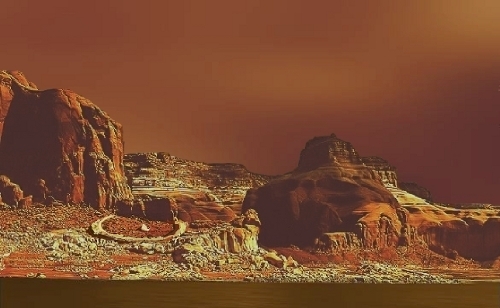
Image: An artist’s impression of Titan’s surface near the shore of one of its lakes, the kind of view we might eventually get from one of the boat/lander missions. Credit: SENER.
You’ll recall that the Huygens lander was designed to float for a time if it landed on a Titanian sea, an outcome mission planners considered a distinct possibility. The interaction between liquid methane and the moon’s weather patterns would be a major area of investigation for any floating probe, as would the complex organic chemistry that makes Titan a unique laboratory for the study of how life develops. Moreover, the sheer drama of operating a craft in an alien lake — or like AVIATR riding the currents of Titan’s thick atmosphere — could enliven public interest, providing a needed boost to deep space planners faced with chronic funding shortfalls.






October 5, 2012
Colors of a Living World
Gliese 581d seems more and more to be considered a habitable zone planet, as Siddharth Hegde (Max Planck Institute for Astronomy) and Lisa Kaltenegger (Harvard-Smithsonian Center for Astrophysics) describe it in a new paper. They’re homing in on how to characterize a rocky exoplanet and point to HD 85512b and Gliese 667Cc as well as Gl581d as examples, but they also assume that we’ll be seeing more and more habitable zone worlds as the Kepler mission continues its work, so how we learn more about these planets becomes a big issue.
In the absence of missions like Terrestrial Planet Finder or ESA’s Darwin, which would allow us to analyze an exoplanetary atmosphere for biomarkers, what else can we do to find the places where life exists? Hegde and Kaltenegger look hard at a planet’s color to find the answer. Specifically, they’re interested in what’s known as a color-color diagram, which takes advantage of the fact that an object can be observed at a variety of wavelengths, with a different brightness becoming apparent in each band observed. ‘Color’ in this sense refers to the difference in brightness between different bands, easily plotted on a color-color diagram.
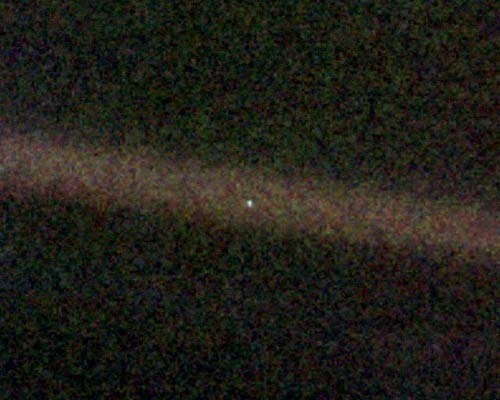
Image: Voyager 1’s famous image of the ‘pale blue dot’ that is our world. Can we use color information from direct images of exoplanets to learn which are most likely to house life? Credit: NASA.
Analyzing an exoplanet in visible light on a color-color diagram can reveal some of the basic physical properties of the planet, assuming cloud cover is not problematic. The new paper homes in on the kinds of environment on Earth that can support extreme forms of life and considers how we might identify equivalent environments on an exoplanet:
Small changes in temperature, pH or other physical and geochemical factors… can lead to such environments being dominant on a potentially habitable exoplanet, what could govern evolution of life. These various “extreme” surface environments on Earth have characteristic albedos in the visible waveband (0.4 µm – 0.9 µm) that could be distinguished remotely. We therefore explore the color signatures that are obtained from the surface environments inhabited by extremophiles as well as test our approach using measured reflection spectra of extremophiles.
Of course, detecting surface features in a reflection spectrum is not itself a detection of life, and the authors are quick to point out that their method is a diagnostic that has to be used in conjunction with a study of the exoplanetary atmosphere. But the paper is an interesting attempt to link the known characteristics of extremophile environments to observational astronomy, one that acknowledges that as we get to the point where we can study distant rocky worlds through actual imagery, we’ll be working at extremely low resolution at the limits of our instruments.
Nonetheless, there is much we can do to distinguish the percentage of the surface covered in water or vegetation or desert, a method that should allow us to prioritize the exoplanets best suited for follow-up spectroscopy. The method builds on prior studies of the vegetation red edge caused by the absorption of red light by photosynthesis, but expands that work to consider different life forms that may live on or below the surface. Piezophiles, for example, thrive under extreme oceanic pressure, while halophiles grow in high salt concentrations.
Although some extremophiles — lichens, bacterial mats and red algae — may be detected by direct albedo measurements, we would have no way of directly detecting many extremophiles in a reflection spectrum. Even so, we can do useful work: The idea here is to identify the kind of surface features that would be common in those environments that supported extremophiles living within them. And the range of characteristic surfaces that can be detected by these methods is large, ranging from water, snow and salt to sand, red-coated algae water and trees.
There are plenty of wild cards here, including the kind of star the planet orbits, which could have a profound effect on the signature of vegetation. As we detect rocky planets around different classes of star, we’ll have to adjust our methods accordingly. From the paper:
…the chlorophyll signature for planets around hot stars, may have a “blue-edge” to reflect some of the high energy radiation in order to prevent the leaves from overheating… Chlorophyll signature for planets orbiting cooler stars, may appear black due to the total absorption of energy in the entire visible waveband such that plants gain as much available light as possible for photosynthetic metabolism… Therefore, the positions of trees, microbial mats and lichens [on the diagram shown in the paper] are only valid for an Earth-analog planet orbiting around a Sun-like star and should be taken as guides. The albedo of vegetation and chlorophyll-bearing organisms for non-Sunlike stars requires further study.
Hegde and Kaltenegger’s paper points toward the first kind of work we’ll be able to perform on an exoplanet in the habitable zone once we’ve been able to acquire a direct image of it. By working with extremophiles, the researchers establish environmental limits for life on our own planet, a useful baseline for our first examinations of other terrestrial worlds. The basic filter photometry in visible light used here can provide a first step in probing these planets by identifying characteristic colors, linking them to environmental niches that support life. We would then await the space-based instruments needed to analyze the atmospheres of high-value targets.
The paper is Hegde and Kaltenegger, “Colors of Extreme ExoEarth Environments,” accepted for publication in Astrobiology (preprint).






October 4, 2012
Cometary Dust Around β Pictoris
New findings from the Herschel space observatory demonstrate how effective the infrared telescope can be at teasing out details of distant planetary systems. At issue is the system around Beta Pictoris, a young star (12 million years old) some 63 light years from the Earth. We’re looking at planetary system formation in progress here, with a single gas giant planet and a dusty debris disk that may be the forerunner of a disk much like our own Edgeworth/Kuiper Belt, the collection of icy bodies that orbits outside the orbit of Neptune.
Ben de Vries (KU Leuven) is lead author of the paper on the new Herschel data, which examines the composition of dust in the outer regions of the Beta Pictoris disk. The study, reported today in Nature, presents a photometric and spectral analysis of dust particles produced when planetesimals in this region collide. The key player here is olivine, a mineral associated with protoplanetary disk material around newborn stars. The olivine found around Beta Pictoris is similar to that found in the dust of primitive Solar System comets.
Herschel has been detecting a magnesium-rich variety of olivine at a distance of 15-45 AU from the star. While olivine can crystallize out of protoplanetary disk material, it eventually becomes part of larger bodies, from comets to asteroids and planets. Usefully, the two states of olivine can be distinguished from each other, as de Vries explains in this ESA news release:
“As far as olivine is concerned, it comes in different flavours. A magnesium-rich variety is found in small and primitive icy bodies like comets, whereas iron-rich olivine is typically found in large asteroids that have undergone more heating, or ‘processing’.”
Moreover, finding olivine in the cold debris disk is itself a marker, for the mineral can only crystallize within about 10 AU of the star. The de Vries team assumes that radial mixing processes are at work, produced not only by stellar winds and heat from the central star but by temperature differences and turbulence in the protoplanetary disk itself. The Herschel data show that olivine crystals make up 3.6 ± 1.0 percent of the total mass of the dust found in this outer region, a figure similar to the Solar System comets 17P/Holmes and 73P/Schwassmann-Wachmann 3, according to de Vries.
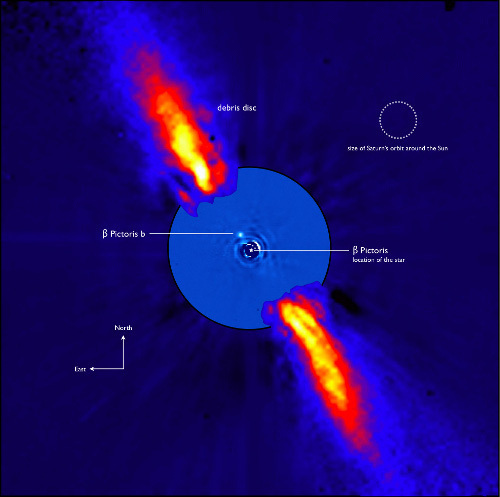
Image: Infrared view of the Beta Pictoris solar system, obtained by combining data from the ADONIS instrument on ESO’s 3.6 m telescope (outer regions) and the NACO instrument on one of the 8.2 m units of ESO’s Very Large Telescope (inner region), and then subtracting the overpowering glare of the central star. The image shows a planet orbiting at roughly the same distance from Beta Pictoris as Saturn is from our own Sun, and a prominent dust disc in the outer reaches of the system. New observations from ESA’s Herschel space telescope have found magnesium-rich olivine crystals in the disc that likely originated from collisions between comets: the dust shares the same compositional characteristics as in several comets in our Solar System. Furthermore, the observation of these olivines in the outer dust disc suggest that they have been transported from their birthplace close to the central star, since they cannot form under the cold conditions found further out. Credits: ESO/A-M. Lagrange et al.
The findings are helpful because they point to basic processes of planetary system growth. Beta Pictoris is one and a half times as massive as the Sun and eight times as bright, but the radial mixing process at work here looks to be roughly the same as that postulated for the early Solar System. Measuring residual materials from an early exoplanetary system is an impressive feat and a reminder of Herschel’s capabilities. Launched in 2009, this is the first observatory to span the entire range from far-infrared to submillimeter wavelengths, pushing deeper into the far infrared than any previous mission. Meanwhile, Beta Pictoris continues to be an ideal ‘laboratory’ for watching a young system grow. It doubtless has much more to teach us.
The paper is de Vries et al., “Comet-like mineralogy of olivine crystals in an extrasolar proto-Kuiper belt,” Nature 490 (04 October 2012), pp. 74-76 (abstract).






October 3, 2012
Remembering “Men Into Space”
Yesterday’s discussion about Man Will Conquer Space Soon!, the landmark series in Collier’s that so elegantly defined the 1950s view of space travel, has me in a retrospective mood. The Collier’s series was highly visible, and those old enough to have seen it tend to remember its concepts whether or not they’re in an aerospace-related profession today. But a few years later a TV show called “Men Into Space” turned up on CBS, fighting for audience share and generally out-publicised by the network’s “Twilight Zone” offering. It would run only a single season and end in September of 1960, months before Yuri Gagarin’s daring ride in a Vostok.
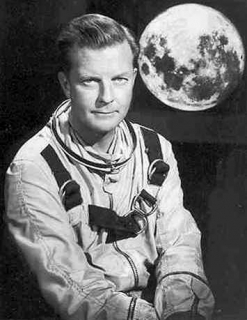
But “Men Into Space” sticks with me for a reason. Its 38 episodes followed Col. Edward McCauley (played by William Lundigan) through a variety of space situations, using him as a viewpoint character while the astronauts he worked with dealt with breakthroughs and problems. In that sense there was a certain similarity to what would become the Mercury program — we can assume this is exactly what the producers had in mind — but in its relatively realistic view of the dangers of these missions, it also harked back to the era of the rocket plane, when test pilots flew the X-15 and its X-series predecessors to new speed and altitude records.
Image: William Lundigan, star of “Men Into Space,” who portrayed a seasoned astronaut guiding an often-changing cast through the dangers of manned spaceflight. Credit: Ziv Television Productions.
It’s that dual emphasis that makes this series interesting. Back in 2003 when I was researching Centauri Dreams in Cleveland, I was headed out to lunch with Marc Millis and Geoff Landis. This was not long after the Columbia disaster and the idea of risk — and its ability to paralyze the space program — was very much in the air. I quoted Landis on this in the book:
“If a test pilot crashes at Edwards Air Force Base…they name a street after him, and the next day someone else flies another mission to see what went wrong. With space, things are different. Every mission has to be a success, we can tolerate no casualties. It may be a cultural thing. Maybe we’ve grown too afraid of risks.”
My thought was that it’s not the people in the machines who fear the risks but the culture that sends them, and in that I agreed with Landis. But these retrospective thoughts about space in the media have me wondering just why — and when — the risk paradigm changed. If you read Tom Wolfe’s The Right Stuff, you’ll recall the mindset that Wolfe identified at Edwards, where Chuck Yeager cracked the sound barrier in the X-1 and Scott Crossfield pushed the X-15 to every limit in the book (Crossfield is famous for saying that the X-15 was one of the few aircraft that caused grown men to cry when it was summarily retired). Wolfe is worth quoting on the idea of risk and how it looked in the late 1950s, when “Men Into Space” was made.
As to just what this ineffable quality was…well, it obviously involved bravery. But it was not bravery in the simple sense of being willing to risk your life. The idea seemed to be that any fool could do that, if that was all that was required, just as any fool could throw away his life in the process. No, the idea here…seemed to be that a man should have the ability to go up in a hurtling piece of machinery and put his hide on the line and then have the moxie, the reflexes, the experience, the coolness, to pull it back in the last yawning moment — and then to go up again the next day, and the next day, and every next day, even if the series should prove infinite — and, ultimately, in its best expression, do so in a cause that means something to thousands, to a people, a nation, to humanity, to God. Nor was there a test to show whether or not a pilot had this righteous quality. There was, instead, a seemingly infinite series of tests…
“Men Into Space,” in a post-Sputnik America that was about to go crazy with the idea of going to the Moon, pushed its astronauts into a variety of Moon landings, space station scenarios, the building of a Moon base and two different attempts to reach Mars. The two Mars missions failed and they were not alone, for this was a show where astronauts occasionally died. Things went wrong and, unlike Neil Armstrong and David Scott’s dangerous Gemini 8 flight, which could easily have proven fatal, many of the “Men Into Space” missions lost their crews. Technical glitches were common and astronauts kept going back into space in spite of all this.
I’m an old movie buff and I particularly enjoy the depiction of aviation in movies of the 1930s and 1940s. Recently I was watching Pat O’Brien and Humphrey Bogart in “China Clipper” (1936), in which a turbo-charged Bogart pushes O’Brien’s new clipper design to the limit, flying through an advancing squall line to demonstrate that the design had what it took to survive the Pacific. Pilots died aplenty in the early days of aviation and it was considered part of the price for learning how to build better aircraft, an approach that fed directly into the culture Wolfe describes at Edwards. It’s an attitude that feeds countless aviation films of this era.
Something happened to our cultural risk paradigm between the late 1950s and the end of Apollo, something that was certainly with us when we lost our two Space Shuttles, and I’m wondering just what it was. My guess is that the rocket-plane pilots of Edwards Air Force Base were never in the public eye to the extent that the Mercury 7 were, and that our decision to mount a national effort to reach the Moon in the context of the Cold War elevated our crews into the kind of public figures whose loss would be unthinkable. The risks of these flights were palpable, but the risk paradigm — what we all felt about those flights and those crews — seemed to be changing.
I suspect that if we do enter into a time of commercial space development, with companies like Planetary Resources actually mining asteroids with human crews launched by SpaceX or other companies, the paradigm will begin to shift again. Sheer numbers will eventually force it to, for a large enough population working on a regular basis in space is a different thing than a single crew facing long odds on a dangerous mission. The show that prompted these musings, “Men Into Space,” doesn’t seem to be available in streaming mode, but I do see various DVDs out there. Like the Collier’s series, it’s an interesting illustration of how our thinking on space has changed.






October 2, 2012
Collier’s: Gorgeous Art, Breathtaking Ideas
In the course of an enjoyable dinner with Douglas Yazell, Shen Ge and Al Jackson (this was in Houston at the 100 Year Starship Symposium), I learned that the Houston section of the American Institute of Aeronautics and Astronautics was in the process of reprinting, in its entirety, the famous Collier’s series on manned spaceflight. Yazell is editor of Horizons, the bi-monthly publication of the Houston group, and fortunately for all of us, it is both online and free. For me, revisiting these stirring articles will be a priority as each comes out. The July/August issue contains Collier’s for March 22, 1952, first in the series.
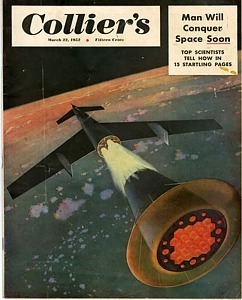
I can only imagine how this issue of Collier’s would have drawn the eye in the typical early 1950s newsstand. The Chesley Bonestell cover shows an enormous winged rocket staging as it soars above an Earth flecked with cloud and crimson with distant sunlight. Evidently we have Scott Lowther to thank for scanning and repairing the entire Collier’s series, a fact he reports on his Unwanted Blog, where he notes that this is the first time these articles have been republished in full-color, high-resolution format since their original release. He does point out that some of the numerous original ads have been edited out — Horizons has replaced these with ads from its Collier’s team members.
According to notes offered by Yazell, Collier’s flagged the upcoming series — to be called Man Will Conquer Space Soon! — with a press release on March 13, 1952, previewing the six articles, totalling 25 pages, that would comprise the first installment of the series. In all, eight issues of the magazine, running into 1954, would offer space articles. Magazine collectors know that UNZ.org has offered the Collier’s series for some time (along with a huge amount of other magazine material), but the UNZ.org scans are low-resolution. The Horizons work restores the series in sharp, gorgeous color.
Space Seizes the Public Imagination
What an impact this series had on the imagination of readers at the time, for not only were the articles written by major figures in the scientific community, including Wernher von Braun, Willy Ley, Fred Whipple and others, but the magazine made liberal use of the illustrations of Chesley Bonestell in addition to fine (and too often neglected) artwork from Rolf Klep and Fred Freeman, not inconsiderable artists in their own right. It’s the Bonestell most people remember first, though, and many young people went on to have these concepts ingrained through three episodes in the Disneyland TV series that were based on the Collier’s concepts.
Physicist A. A. Jackson goes so far as to say, in this same issue of Horizons, that the Collier’s series may have made the Apollo program a reality by influencing countless young people to pursue careers in spaceflight. It certainly, five years before Sputnik, seized the public imagination, a possibility von Braun’s friend Willy Ley must have foreseen when he took the idea for the project to Cornelius Ryan, then an editor at Collier’s. The series drew liberally from material von Braun had developed for a science fiction novel he called Project MARS: A Technical Tale, whose appendix would become the basis of a space series in a German spaceflight journal. Von Braun’s Mars novel would eventually find an English publisher and it remains in print through the University of Illinois Press.
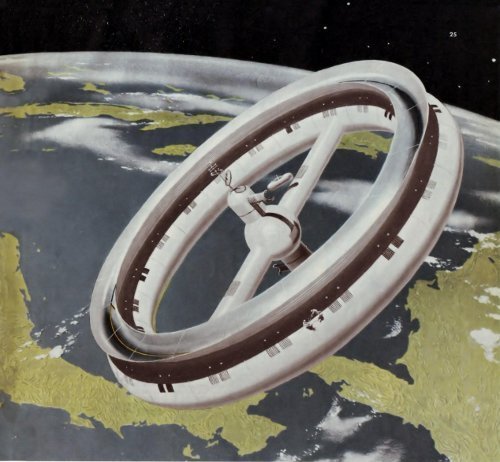
Image: Chesley Bonestell’s space station distilled earlier science fiction concepts into a vivid image that would recur in 1950s SF films like Conquest of Space (Bonestell did background space art for the movie, which also tapped von Braun’s ideas). Credit: Collier’s.
If you want to see what space as a goal felt like in the early 1950s, take a look at these pages, where the excitement is palpable and the technology seemed just around the corner. So many of the tropes of the era’s science fiction films had their genesis here, as witness not just von Braun’s winged rockets but the enormous wheel of a space station being serviced by tiny space taxis, the latter rendered in detailed cross-section by Fred Freeman’s talented brush. Bonestell’s painting of a manned lunar orbiter, with its three bulbous chambers connected by scaffolding, captures the wonder of a first glimpse of the far side of the Moon and a soon to be burgeoning space race caught up in the geopolitics of the Cold War. The Collier’s editors were careful to position space as an arena for a competition the US could not afford to lose. From their introduction:
When the atomic bomb program — the Manhattan Project — was initiated, nobody really knew whether such a weapon could actually be made. The famous Smyth Report on atomic energy tells us that among the scientists there were many who had grave and fundamental doubts of the success of the undertaking. It was a two-billion-dollar technical gamble.
Such would not be the case with a space program. The claim that huge rocket ships can be built and a space station created still stands unchallenged by any serious scientist. Our engineers can spell out right now (as you will see) the technical specifications for the rocket ship and space station in cut-and-dried figures. And they can detail the design features. All they need is time (about ten years), money and authority.
Coming up next in the Horizons reprint series is the October 18, 1952 issue of Collier’s, devoted to the Moon and the attempt to land humans on it. The editorial of that issue notes that an expanded version of the March 22nd articles had already appeared as a book called Across the Space Frontier from Viking Press, a sure indication of the surge in interest the magazine had created. It also mentioned the Third International Congress on Astronautics, which had just met in Stuttgart, where a von Braun paper was read. For many, the Collier’s series took science fiction into the realm of engineering reality, matching vivid space imagery with ongoing scientific research. It was a mind-bending, career-changing journey whose pages repay our continued attention.






Paul Gilster's Blog
- Paul Gilster's profile
- 7 followers



